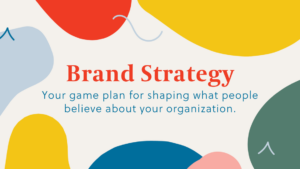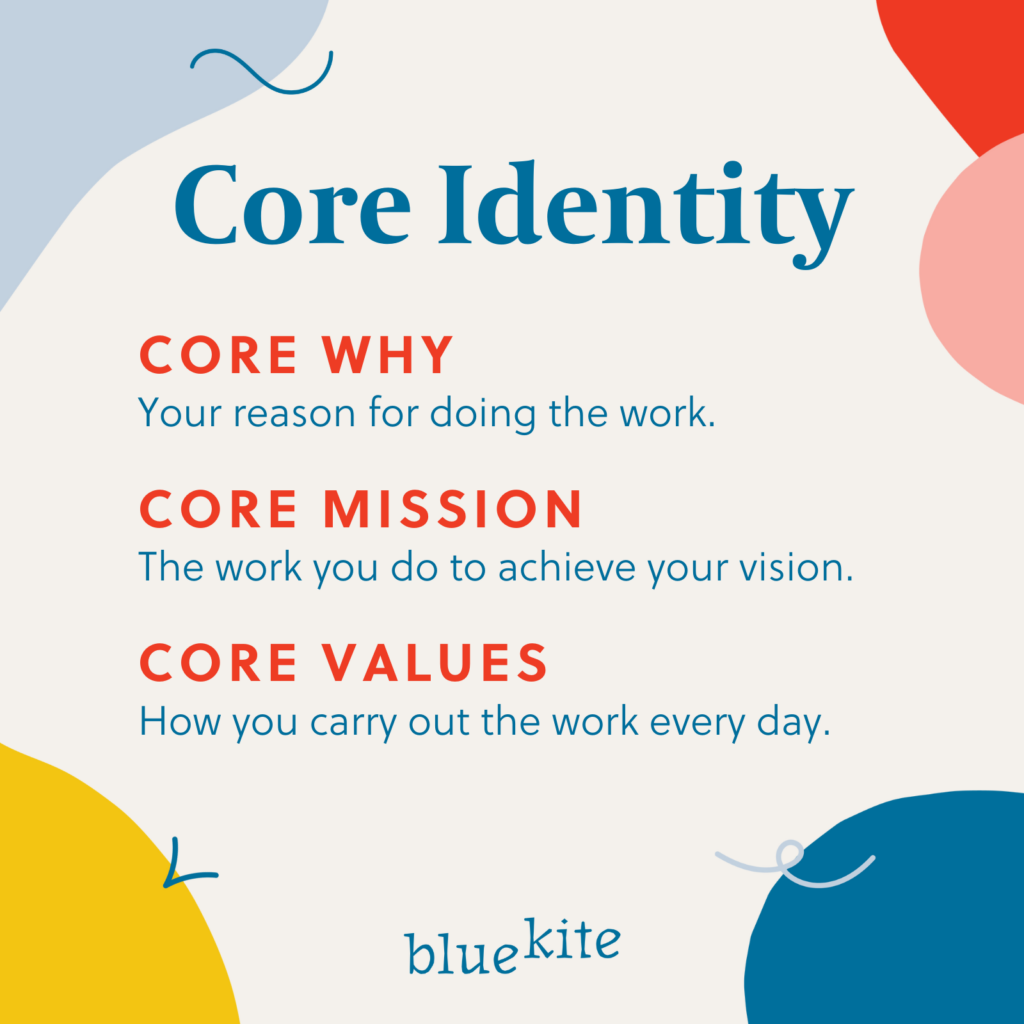Have you ever visited a website and felt like it was created just for you? Or, have you ever seen an advertisement and thought, “Wow, it’s like they knew exactly what I wanted.”?
This doesn’t happen by accident.
It’s the result of a carefully crafted brand strategy. When your organization has a strong brand strategy, you make it easier for your target audience to find you, buy from you and tell others about you.
That’s what you want for your business, right?
So, let’s take a look at what a brand strategy is, why you need one and how to build it.
What is Brand Strategy?
A brand strategy is your game plan for how you show up in the world.
It plants a flag by what you stand for as an organization and how you communicate that to your audience. Essentially, your branding should succinctly encapsulate your company’s mission and promise to your customers.
When done well, your brand strategy will shape what people think about your company. That’s why it’s so important to get it right.
Think about the some of the best and most beloved brands in the world——Coca-Cola, Nike, Starbucks, Google, Chik-Fil-A.
It’s not an accident that people love these companies. Yes, they have great products. But, they also have a well-designed brand strategy that positions their business in a certain way in the minds of customers.
Everything these companies do reiterates who they are as a brand. And because of that, it’s easier for people to identify with them and choose to support them (or not).
Why Your Business Needs a Brand Strategy
It might already be clear to you why your business needs a brand strategy.
But if you need some additional rationale, here are several reasons why your organization should take the time to build a brand strategy:
- It helps you stand out. Your brand strategy clearly positions your organization in the minds of your target audience. And when you do that well, it helps you stand out in a sea of competition because you are speaking clearly and directly to your people.
- It helps you build strong culture. Want a strong company culture? It starts with a solid brand strategy that articulates the mission, vision and values of your organization. Your brand strategy serves as a foundation for how your team shows up to work every day, gives them a clear sense of purpose and creates loyalty to your organization.
- It guides decision-making. When you know what your organization stands for and against, it guides decision-making because you can clearly see what’s consistent with your brand. Without a brand strategy, organizations tend to lose their way and stray from their original mission. A clear brand strategy gives you the framework to ask the question – is this consistent with who we are?
- It helps you create consistency. A brand strategy will establish consistency across your organization——both in what and how you communicate about your brand. It helps you develop a common written and visual language around what you do.
- It makes marketing easier. When you have clearly established your brand strategy, how and where to market your organization comes much more naturally. Otherwise, marketing can feel like you’re constantly chasing rabbits or going after the latest shiny object.
How to Build a Brand Strategy for Your Business
Now that you understand the importance of building a brand strategy, let’s look at what it should include. Here are the key components to include in your brand strategy:
1. Core identity = who you are
Your core identity is the encapsulation of who you are and what you stand for as a business. There are three key pieces to this——your core why, your core mission and your core values.
- Your core why articulates the reason you started your organization in the first place. This is often called a vision statement. It’s the change you hope to create in the world through your work. It’s the goal you are driving toward every day.
- Your core mission is WHAT you do. It’s the work you are doing every day to achieve your vision or core why.
- Your core values is HOW carry out your work as an organization. Your core values establish what you believe as an organization and serves as an important driver of your company culture.

To give you an example of how this looks, here’s the core identity we built for Encircle Acupuncture, a Nashville-based community acupuncture clinic:
Core Why:
To make healthcare accessible to everyone.
Core Mission:
To make acupuncture affordable and accessible for as many people as possible by treating patients in a low-cost, high-volume community setting.
Core Values:
- Create a safe and inviting space for all.
- Keep it simple.
- Bring your best.
- Lead with love and gratitude.
See how this works? Just by reading these short statements, you can quickly get an idea of what Encircle Acupuncture is all about.
The same should be true for your organization. Skip the muddled platitudes and lengthy mission statements laced with platitudes. Your core identity should be simple, straightforward and get to the heart of what your organization is about.
Before you do anything else, you have to gain clarity around your core identity and build everything else around that.
2. Competitive advantage = why you’re different
Your competitive advantage is what makes you stand out. It’s your special sauce or the reason people choose your business over the other choices in your market.
Most businesses have it. But not every business knows what it is.
That’s why it’s important to take the time to figure this out. Start by taking a look at your competitors and identifying the things that you do differently than everyone else.
One word of caution——oftentimes what you think is your competitive advantage is not really the case. It can take some outside help to see this clearly. But if you’re doing this work yourself, getting feedback from customers is another crucial step to identifying your competitive edge.
Determine your competitive advantage by answering these questions…
- What unique problem are we best at solving?
- What is our unique approach to solving this problem? Or, what is the thing that only we do?
- In what areas are we strong that our competitors are weak?
- What areas are our competitors ignoring that we tackle or own?
- What market opportunities exist that we can exploit? In other words, are there markets not being served that we can tap into?
- Who are the people that benefit most from our solution? In other words, who can we help the most?
It sounds counterintuitive, but narrowing down what you offer and who you serve can go a long way toward helping you attract more of the right customers. Being specific makes it easier for your target audience to see how you are the perfect solution for their needs.
Without this important step, you’ll look and sound like everyone else. That’s why understanding your competitive advantage is key to a successful brand strategy.
Need help finding your competitive advantage? Take our free competitive advantage quiz to discover what makes your business stand out.
3: Audience profiles = who you serve
Your audience profile is a detailed description of your ideal customer. This is your target audience personified. You might hear this called buyer personas.
In other words, instead of simply saying your target audience is fit, young women who love to run, you build a descriptive profile of that person.
Here’s what that could look like:
See the difference?
When you build an audience profile, it’s easier to craft messaging that connects with people because it will feel like it was written just for them.
Audience profiles force you to go beyond demographics to talk to the real, live people you are trying to attract. When you do this foundational work well, your messaging will connect with your audience because it will feel like it was created just for them.
Still not sure how to do this? Think about your best customer and write down the characteristics of this person. Sure, you can include demographic information such as age, gender, location, income, etc. But, I encourage you to look beyond that.
Here are some questions to ask yourself to build your audience profile:
- What does he love?
- What does he hate?
- What is his biggest pain point right now?
- What caused him to look for a solution?
- What was his biggest hesitation to a solution like yours?
- What does he love most about your business?
- What do you love most about this customer?
This isn’t an all-inclusive list, but it’s a good place to start. And if you need help, talk to some of your best customers and ask these questions. Or, better yet, survey your customers to get better insight into what matters most to them.
4. Brand Positioning = how to tell your story
After nailing down the other pieces of your brand strategy, your brand positioning communicates what you do, who you best serve and what benefits you offer them.
This is often called a core value proposition. It’s a one or two sentence statement that serves as the guiding force for all of your branding and marketing efforts moving forward.
For example, here’s the core value proposition we wrote for our acupuncture clinic client:
Encircle Acupuncture helps people suffering from pain, stress and anxiety get relief by offering simple, effective acupuncture treatment and quality care – all at an unbeatable price.
This one statement very clearly articulates who they help and how they do it.
Brand personality
Another part of brand positioning is articulating your brand personality. It helps lay the foundation for how you communicate about your brand. For instance, a buttoned-up, polished personality is going to look and sound a lot different than one that’s more laid-back and fun.
In the case of the acupuncture clinic, we developed their brand personality around the idea of a friendly neighborhood bartender who is good at offering warm, approachable service while lending an ear or a shoulder to cry on.
Your brand personality breathes life into your business and makes it more relatable to your audience. Think about how you want to show up in the world and create a personality around that. It will make your marketing messages stand out.
Key Messages
The final piece of brand positioning is the key messages you will use to communicate about your brand. These are the things you want your audience to remember about your brand. They will serve as guideposts for all of your marketing efforts moving forward.
Start by identifying three key themes you want to communicate. If you have any more than that, it will muddle your messaging.
These key messaging themes can be a word or short phrase. For instance, in the case of our acupuncture clinic client, we built our messaging around these key themes——affordable, simple, compassionate.
From there, you can build out supporting language to use throughout your marketing efforts. This will help your marketing team implement your brand strategy.
What Should You Do After Creating a Brand Strategy?
Now that you have a brand strategy in place, it’s time to put it into action! A brand strategy won’t do you any good sitting in a drawer. It’s important to take the work you’ve done with your strategy and implement these changes throughout your organization.
In some cases, this will mean you need to look at changing the visual representation of your brand, such as your logo, website and marketing materials to better match your new strategy.
Or, it might mean more subtle changes such as updating your marketing messages and channels to better reflect your new approach.
Either way, you will be far better poised to make decisions about your branding and marketing efforts with a solid brand strategy in place.
Ready to build a brave new brand?
Feeling overwhelmed by the brand strategy process? Not to worry. We make it easy (and fun).
Contact us to see if we’re a good fit to work together. We’d love to help you create a brave new brand.
Originally published on October 19, 2019. Updated on April 26, 2023.







